brake DODGE STRATUS COUPE 2005 2.G Owners Manual
[x] Cancel search | Manufacturer: DODGE, Model Year: 2005, Model line: STRATUS COUPE, Model: DODGE STRATUS COUPE 2005 2.GPages: 396
Page 6 of 396
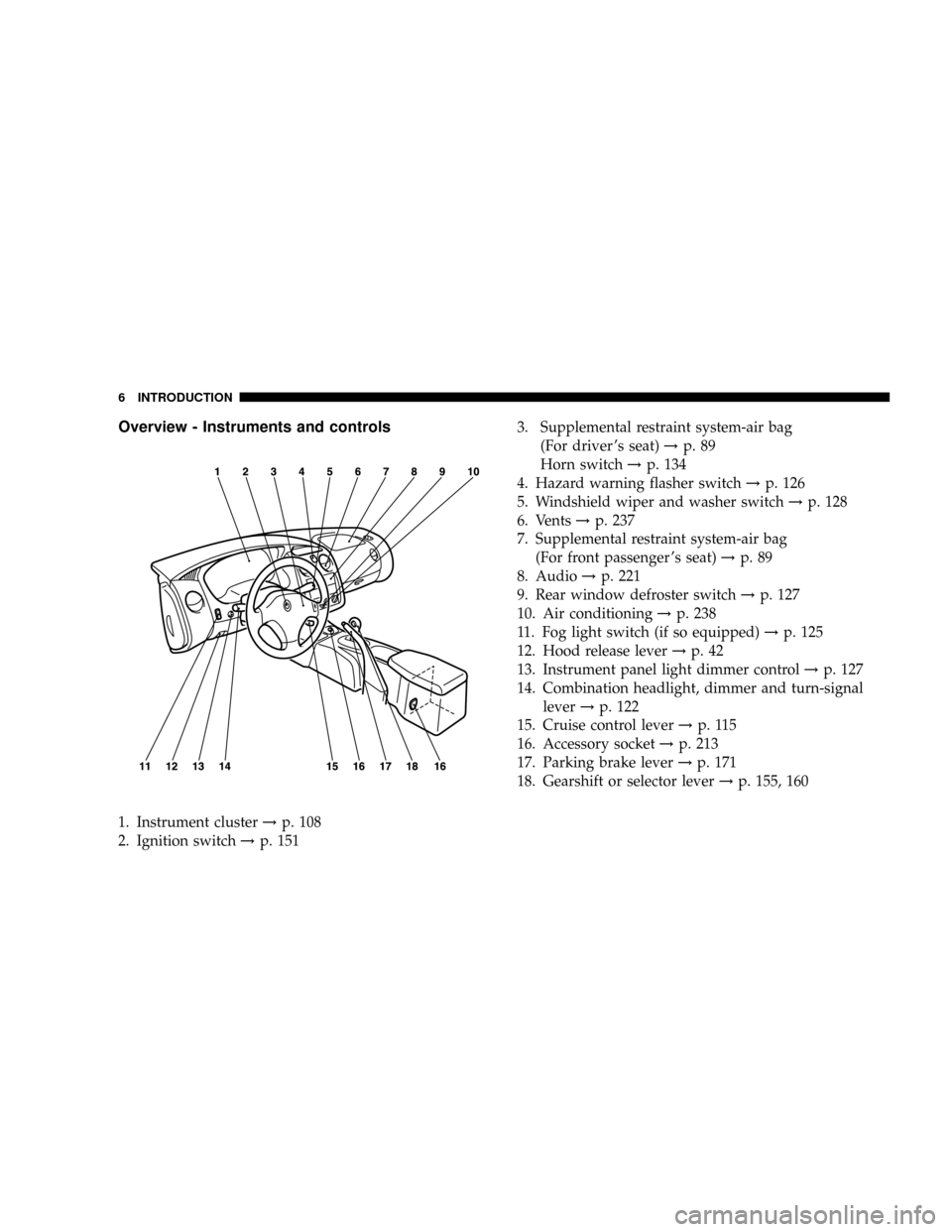
Overview - Instruments and controls
1. Instrument cluster!p. 108
2. Ignition switch!p. 1513. Supplemental restraint system-air bag
(For driver 's seat)!p. 89
Horn switch!p. 134
4. Hazard warning flasher switch!p. 126
5. Windshield wiper and washer switch!p. 128
6. Vents!p. 237
7. Supplemental restraint system-air bag
(For front passenger 's seat)!p. 89
8. Audio!p. 221
9. Rear window defroster switch!p. 127
10. Air conditioning!p. 238
11. Fog light switch (if so equipped)!p. 125
12. Hood release lever!p. 42
13. Instrument panel light dimmer control!p. 127
14. Combination headlight, dimmer and turn-signal
lever!p. 122
15. Cruise control lever!p. 115
16. Accessory socket!p. 213
17. Parking brake lever!p. 171
18. Gearshift or selector lever!p. 155, 160
6 INTRODUCTION
Page 10 of 396
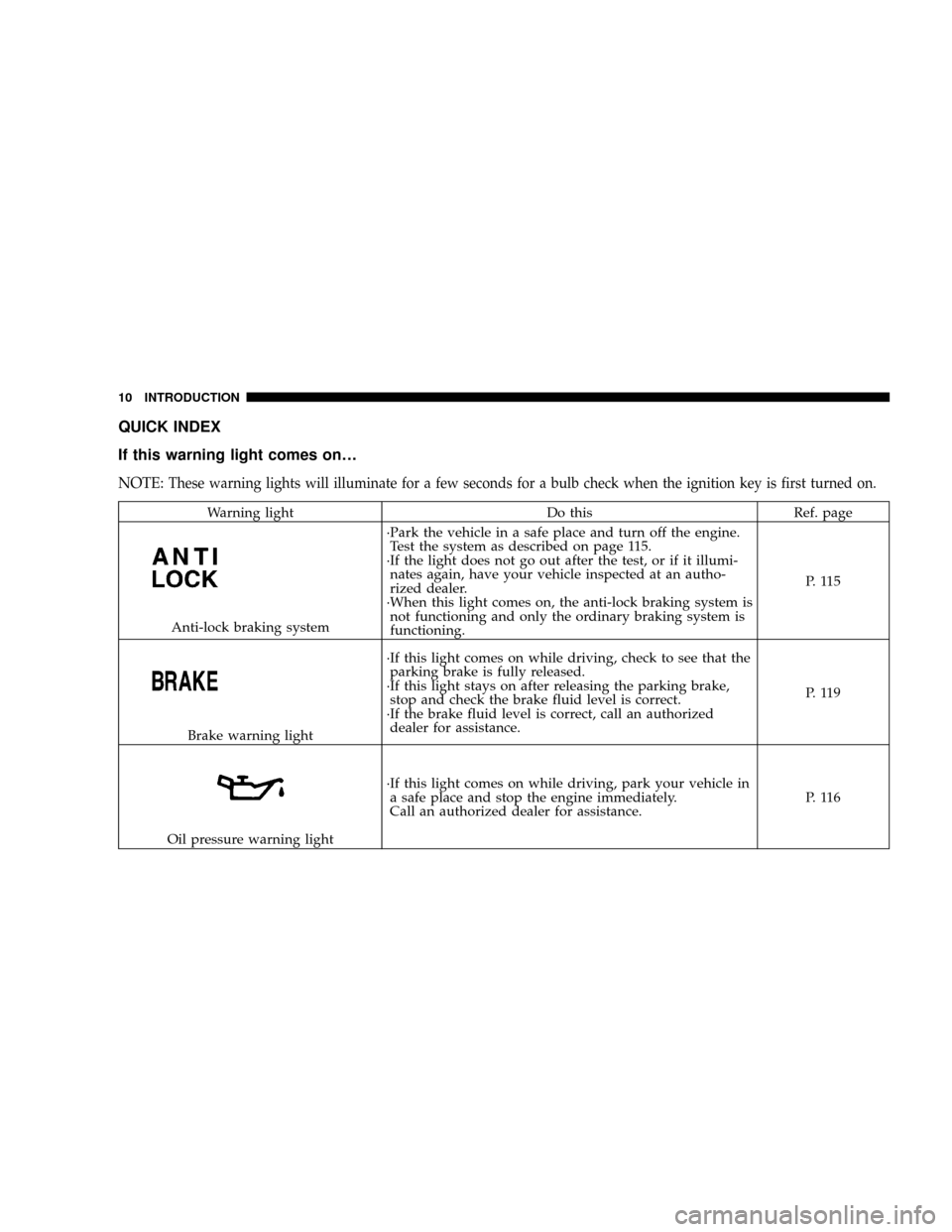
QUICK INDEX
If this warning light comes on¼
NOTE:These warning lights will illuminate for a few seconds for a bulb check when the ignition key is first turned on.
Warning light Do this Ref. page
´Park the vehicle in a safe place and turn off the engine.
Test the system as described on page 115.
´If the light does not go out after the test, or if it illumi-
nates again, have your vehicle inspected at an autho-
rized dealer.
´When this light comes on, the anti-lock braking system is
not functioning and only the ordinary braking system is
functioning.P. 1 1 5
Anti-lock braking system
´If this light comes on while driving, check to see that the
parking brake is fully released.
´If this light stays on after releasing the parking brake,
stop and check the brake fluid level is correct.
´If the brake fluid level is correct, call an authorized
dealer for assistance.P. 1 1 9
Brake warning light
´If this light comes on while driving, park your vehicle in
a safe place and stop the engine immediately.
Call an authorized dealer for assistance.P. 1 1 6
Oil pressure warning light
10 INTRODUCTION
Page 14 of 396

If you hear the sound¼
Sound Do this Ref. page
If you hear a metallic sound (squeal)
when you depress the brake pedal
while driving.ªBrake pad wear alarmº
The brake pads have worn down near the serviceable
limit.
Have the brake pads replaced at an authorized dealer.P. 174
If you hear a chime from the engine
compartment continuously while the
engine is on.ªBrake system (hydraulic brake booster) warning chime
(Vehicle with anti-lock braking system)º
The brake circuit may not be operating correctly.
If this chime does not stop after a few minutes, carefully
stop the vehicle in a safe location and contact your nearest
authorized dealer.P. 1 1 9
14 INTRODUCTION
Page 16 of 396

If this problem occurs¼
Problem Do this Ref. Page
Cannot turn the key
(1)ªLOCKº to ªACCº
Turn the key while slightly turning the steering wheel
right and left.
(2)ºACCº to ªLOCKº
Vehicle with automatic transaxle
Check the position of gear selector lever.
The key cannot be removed unless the gear selector
lever is set to the ªPº (PARK) position.
Vehicle with manual transaxle
Place the key at the ``ACC'' position. Push the key in
and turn it.P. 153
Cannot shift the gear selector lever
from the ªPº (PARK) positionShift the gear selector lever while depressing the brake
pedal. Check if the ignition key is in the ªONº position.P. 156, 161
The windows are fogged up.
1.Set the heater/air conditioning mode selection dial to
the ªºorªº position.
2.Turn on the blower.P. 246
16 INTRODUCTION
Page 18 of 396

If this problem occurs¼
Problem Do this Ref. page
The vehicle is stuck in sand, mud, or
snow.1. Carefully rock the vehicle by shifting the transmission
from low to reverse.
WARNING
1.When attempting to rock your vehicle out of a stuck
position, be sure that no one is near the vehicle. The
rocking motion may cause the vehicle to suddenly lurch
forward or backward, and injure bystanders.
2.Avoid racing the engine or spinning the wheels.
Prolonged efforts to free a stuck vehicle may result in
overheating and transaxle failure.
If the vehicle remains stuck after several rocking
attempts, have a towing service pull the vehicle out.P. 263
The brakes are not functioning
properly after crossing a puddle or
stream.Dry out the brakes by driving slowly while lightly
depressing the brake pedal.Ð
18 INTRODUCTION
Page 58 of 396
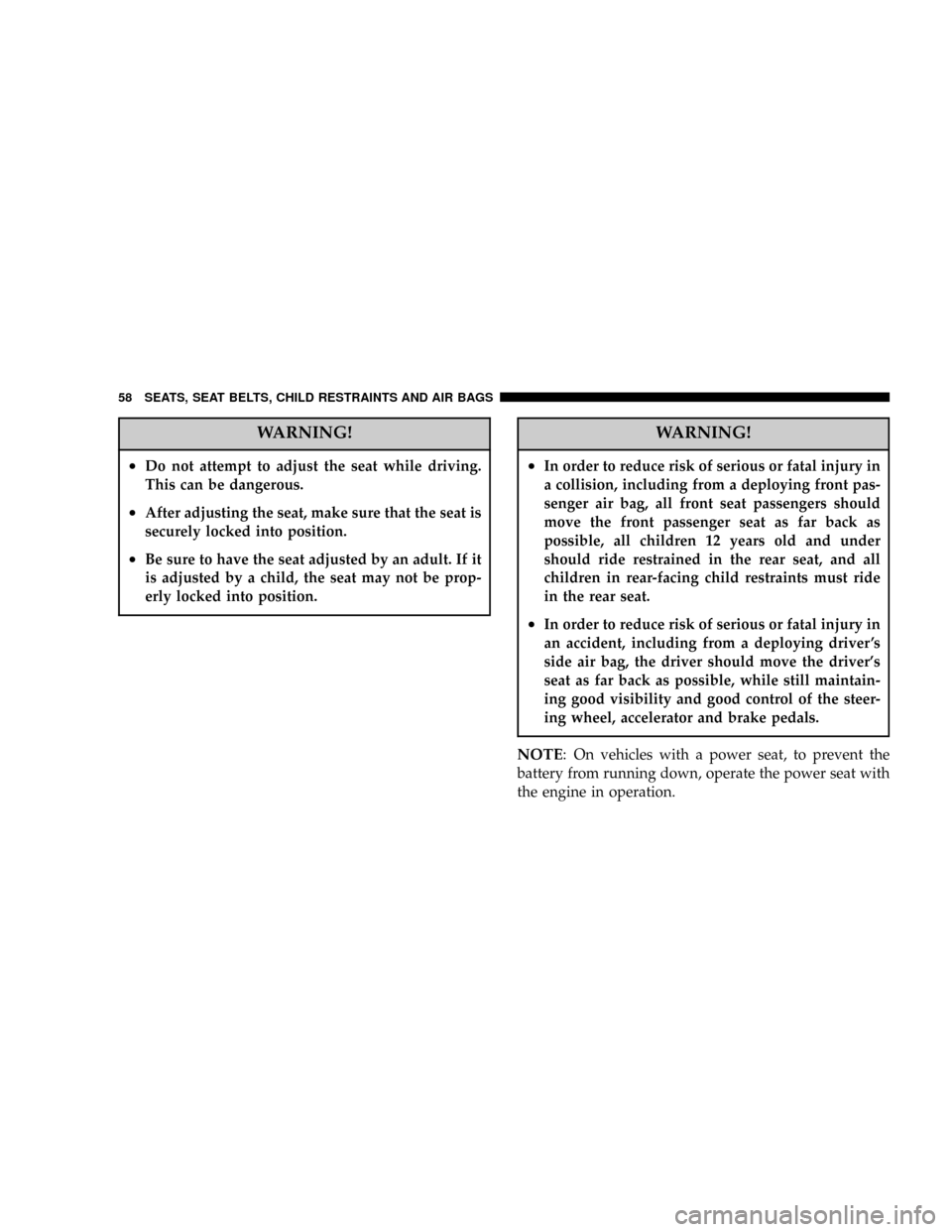
WARNING!
²Do not attempt to adjust the seat while driving.
This can be dangerous.
²After adjusting the seat, make sure that the seat is
securely locked into position.
²Be sure to have the seat adjusted by an adult. If it
is adjusted by a child, the seat may not be prop-
erly locked into position.
WARNING!
²In order to reduce risk of serious or fatal injury in
a collision, including from a deploying front pas-
senger air bag, all front seat passengers should
move the front passenger seat as far back as
possible, all children 12 years old and under
should ride restrained in the rear seat, and all
children in rear-facing child restraints must ride
in the rear seat.
²In order to reduce risk of serious or fatal injury in
an accident, including from a deploying driver 's
side air bag, the driver should move the driver's
seat as far back as possible, while still maintain-
ing good visibility and good control of the steer-
ing wheel, accelerator and brake pedals.
NOTE: On vehicles with a power seat, to prevent the
battery from running down, operate the power seat with
the engine in operation.
58 SEATS, SEAT BELTS, CHILD RESTRAINTS AND AIR BAGS
Page 68 of 396
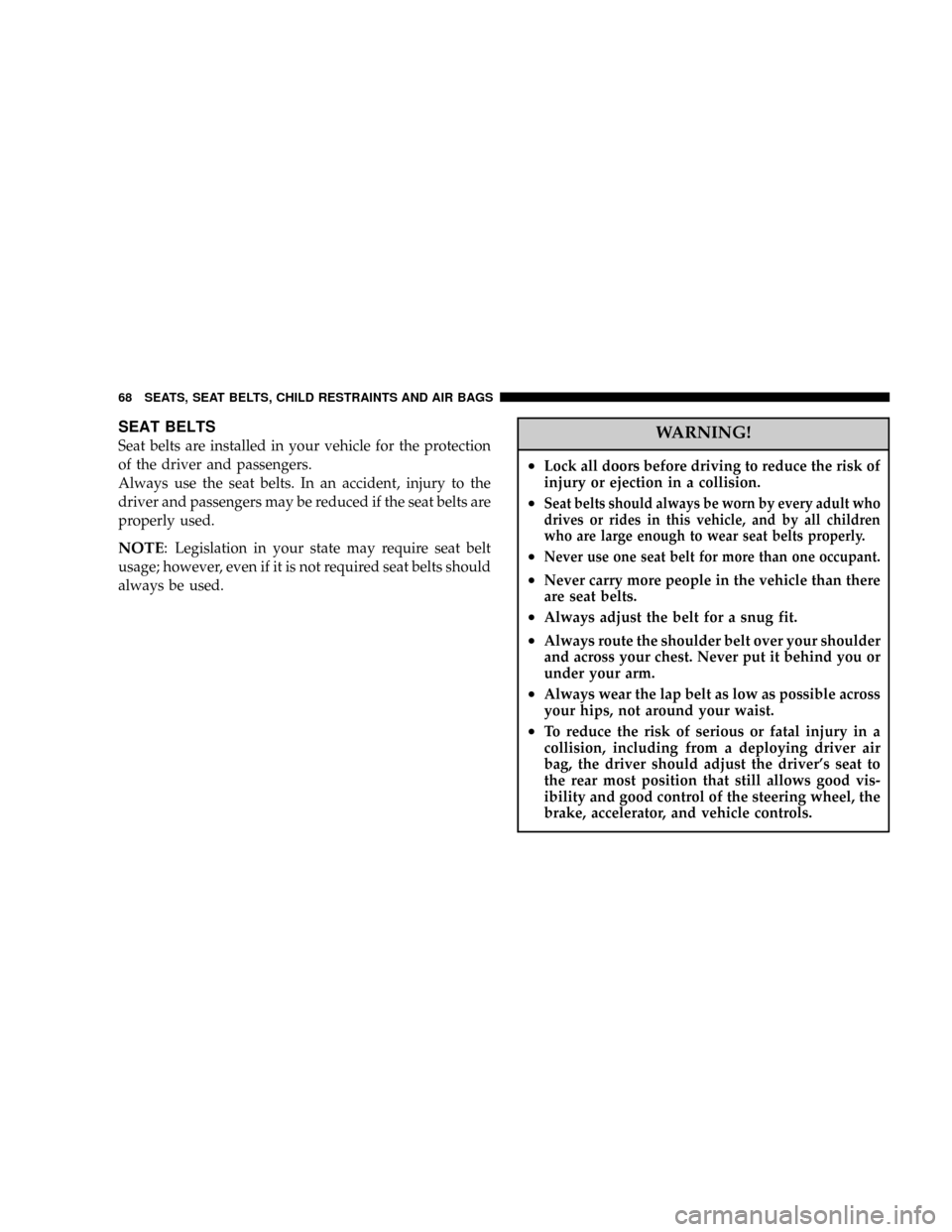
SEAT BELTS
Seat belts are installed in your vehicle for the protection
of the driver and passengers.
Always use the seat belts. In an accident, injury to the
driver and passengers may be reduced if the seat belts are
properly used.
NOTE: Legislation in your state may require seat belt
usage; however, even if it is not required seat belts should
always be used.
WARNING!
²Lock all doors before driving to reduce the risk of
injury or ejection in a collision.
²Seat belts should always be worn by every adult who
drives or rides in this vehicle, and by all children
who are large enough to wear seat belts properly.
²Never use one seat belt for more than one occupant.
²Never carry more people in the vehicle than there
are seat belts.
²Always adjust the belt for a snug fit.
²Always route the shoulder belt over your shoulder
and across your chest. Never put it behind you or
under your arm.
²Always wear the lap belt as low as possible across
your hips, not around your waist.
²To reduce the risk of serious or fatal injury in a
collision, including from a deploying driver air
bag, the driver should adjust the driver's seat to
the rear most position that still allows good vis-
ibility and good control of the steering wheel, the
brake, accelerator, and vehicle controls.
68 SEATS, SEAT BELTS, CHILD RESTRAINTS AND AIR BAGS
Page 105 of 396

INSTRUMENTS AND CONTROLS
CONTENTS
mInstrument cluster......................108
NMeter cluster.........................108
NIndicator and warning light package........109
NSpeedometer.........................110
NTachometer..........................110
NFuel gauge..........................111
NOdometer/Trip odometer................112
NEngine coolant temperature gauge..........113
NTurn signal indicators/hazard warning lights . . 114
NHigh beam indicator...................114
NTheft-alarm indicator...................114
NDoor-ajar warning light and chime.........114NAnti-lock braking system warning light
(if so equipped).......................115
NCruise/speed control indicator............115
NLow-fuel warning light and chime..........115
NFront fog light indicator (if so equipped).....116
NCharging system warning light............116
NOil pressure warning light...............116
NMalfunction indicator light
(SERVICE ENGINE SOON)...............117
NSupplemental Restraint System (SRS)-air bag
warning light.........................118
NBrake warning light....................119
NSeat belt reminder/warning light...........120
4
Page 109 of 396
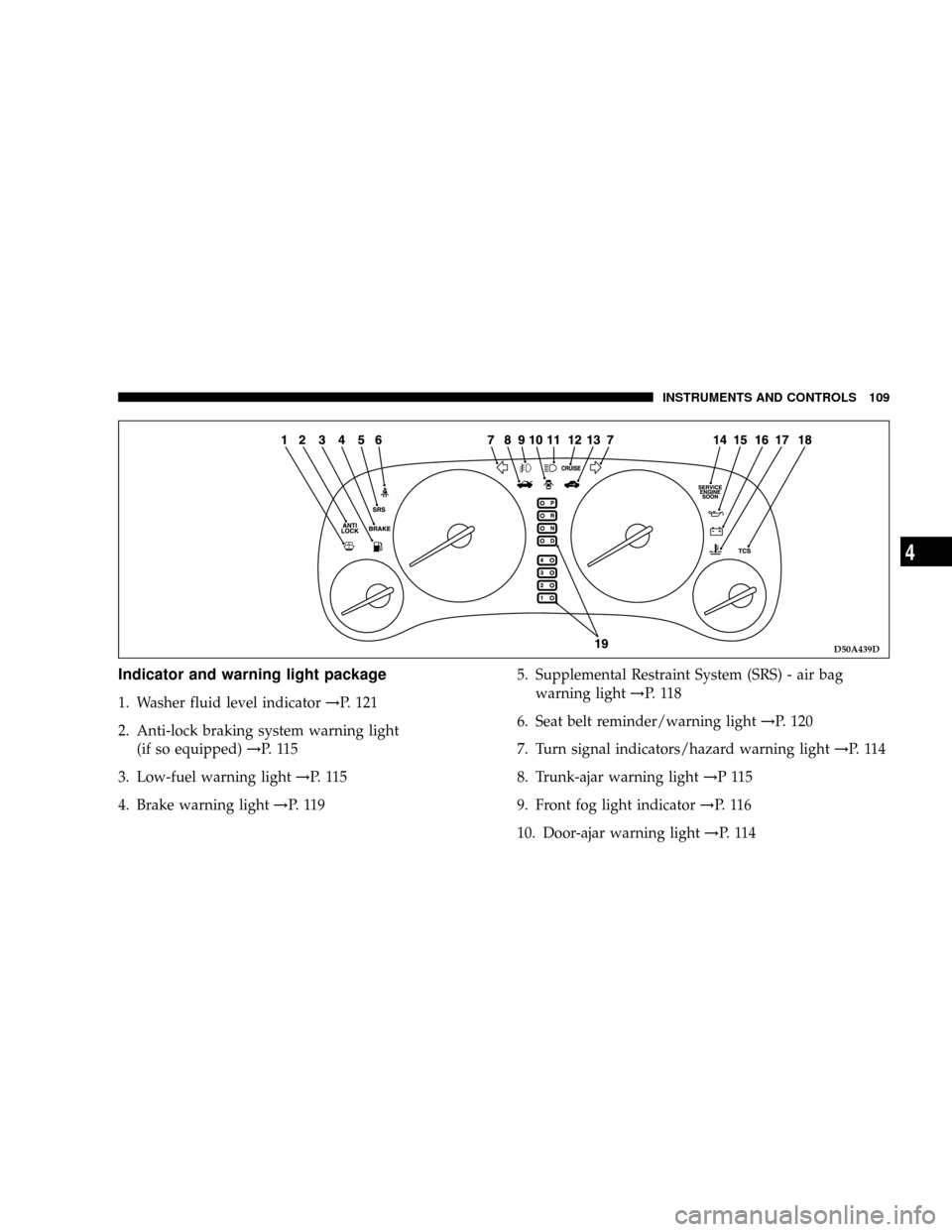
Indicator and warning light package
1. Washer fluid level indicator!P. 121
2. Anti-lock braking system warning light
(if so equipped)!P. 1 1 5
3. Low-fuel warning light!P. 1 1 5
4. Brake warning light!P. 1 1 95. Supplemental Restraint System (SRS) - air bag
warning light!P. 1 1 8
6. Seat belt reminder/warning light!P. 120
7. Turn signal indicators/hazard warning light!P. 1 1 4
8. Trunk-ajar warning light!P115
9. Front fog light indicator!P. 1 1 6
10. Door-ajar warning light!P. 1 1 4
D50A439D
INSTRUMENTS AND CONTROLS 109
4
Page 115 of 396
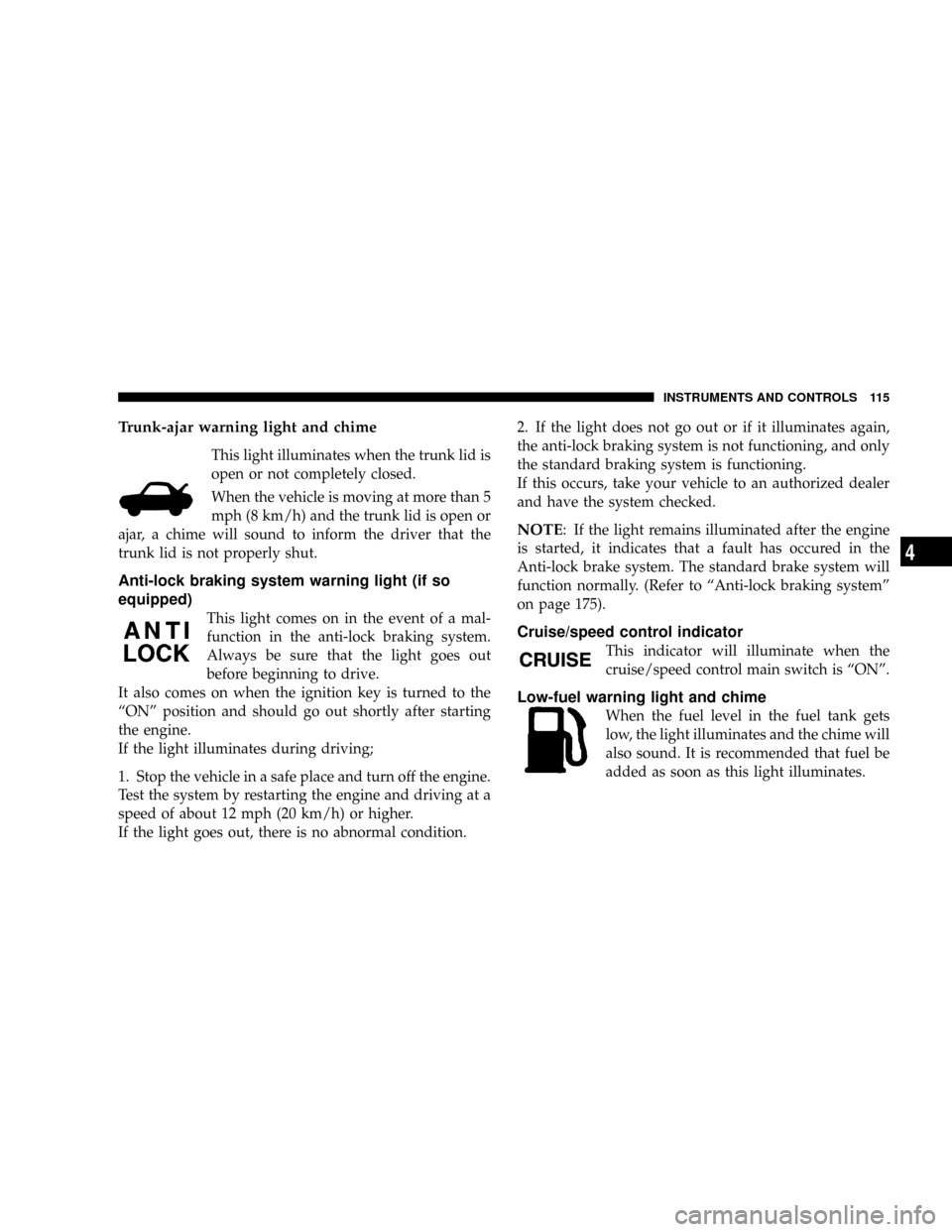
Trunk-ajar warning light and chime
This light illuminates when the trunk lid is
open or not completely closed.
When the vehicle is moving at more than 5
mph (8 km/h) and the trunk lid is open or
ajar, a chime will sound to inform the driver that the
trunk lid is not properly shut.
Anti-lock braking system warning light (if so
equipped)
This light comes on in the event of a mal-
function in the anti-lock braking system.
Always be sure that the light goes out
before beginning to drive.
It also comes on when the ignition key is turned to the
ªONº position and should go out shortly after starting
the engine.
If the light illuminates during driving;
1. Stop the vehicle in a safe place and turn off the engine.
Test the system by restarting the engine and driving at a
speed of about 12 mph (20 km/h) or higher.
If the light goes out, there is no abnormal condition.2. If the light does not go out or if it illuminates again,
the anti-lock braking system is not functioning, and only
the standard braking system is functioning.
If this occurs, take your vehicle to an authorized dealer
and have the system checked.
NOTE: If the light remains illuminated after the engine
is started, it indicates that a fault has occured in the
Anti-lock brake system. The standard brake system will
function normally. (Refer to ªAnti-lock braking systemº
on page 175).
Cruise/speed control indicator
This indicator will illuminate when the
cruise/speed control main switch is ªONº.
Low-fuel warning light and chime
When the fuel level in the fuel tank gets
low, the light illuminates and the chime will
also sound. It is recommended that fuel be
added as soon as this light illuminates.
INSTRUMENTS AND CONTROLS 115
4